
Journal of Clinical Chemistry and Laboratory Medicine
Open Access
ISSN: 2736-6588

ISSN: 2736-6588
Research Article - (2022)Volume 5, Issue 1
Introduction: Aging is a slow and progressive process different from disease, whose main cause is the presence of free radicals and oxidative attacks on mitochondrial DNA in the body. The frequency of mitochondrial DNA deletions would increase exponentially from the age of 50 years to reach considerable levels in older people Objectives: To measure the antioxidant activity of the plasma of healthy women without chronic pathology whose etiology would be related to the oxidative stress, and whose age is lower or equal to 50 years, by scavenging of the free radical ABTS•+.The aim of the study is to observe the evolution of the antiradical capacity of the blood with age, up to 50 years.
Results: The mean antiradical activity of women of ages>40 years was 2.2% higher than that of women of age’s ≤ 40 years. The antiradical activity of overweight women with a Body Mass Index (BMI) greater than 25 and a mean age of 42.16 ± 7.78 years was more or less equivalent to that of normal-bodied women with a BMI less than 25 having a mean age of 36.25 ± 8.95 years. The mean antiradical activity of women with less than 3 gestation and a mean age of 32.25 ± 7.13% is little different from that of women with gestation of 3 or more with a mean age of 44.83 ± 4.35%. The mean antiradical activity of women with parities less than 3 and a mean age of 35 ± 7.32 years is equivalent to that of women with parities greater than or equal to 3 with a mean age of 47.83 ± 2.16%. The antiradical activity of the plasma of women consuming 2 to 3 fruits and vegetables per day with a mean age of 43.6 ± 4.39 is about 3.5% higher than those of women consuming only 1 fruit and vegetable/day with a mean age of 36 ± 10.07.
Conclusion: The evaluation of the total antioxidant capacity of women's blood by radical scavenging shows that a slight oxidative stress is already progressively established in the blood plasma of women up to the age of 50. The consumption of fruits and vegetables enriches the organism in antioxidant compounds. A gestité and parity superior or equal to 3 slow down the appearance of oxidative stress.
Healthy women; Plasma; Age; Body mass index; Gestation; Parity; Fruit and vegetable consumption; Total antioxidant capacity; ABTS
In biological systems, the production of Reactive Oxygen Species (ROS) is counterbalanced by antioxidant systems such as ascorbic acid, α-tocopherol, and enzymes of which the most representative are catalase, the family of superoxide dismutases, glutathione peroxidase, and glutathione reductase [1-5]. This equilibrium is disrupted under certain conditions such as an increase in the production of activated forms of oxygen (exposure to high O2 concentrations, bacterial infection, etc.) or a decrease in the efficiency of antioxidant systems [5]. An increase in intracellular concentrations of ROS responsible for oxidative stress is then observed [6-8]. In humans, oxidative damage to DNA, lipids and proteins is associated with certain chronic diseases such as cardiovascular disease [9], certain cancers [10], diabetes [11], inflammatory diseases, Alzheimer's disease and other neurodegenerative diseases [12], as well as the aging process [5].
Aging is a set of physiological and psychological processes that change the structure and functions of the body from middle age [13-15]. It is a slow and progressive process that differs from disease, whose main cause is the presence of free radicals in the body. Since ageing is accompanied by oxidative damage of biomolecules with a possible increase of ROS, we propose in this study to evaluate the antioxidant activity of plasma of subjects of the same sex, of different ages, without chronic disease related to oxidative stress. This will allow highlighting the effect of age on the total antioxidant capacity of human blood. The free radical activity was measured by scavenging the free radical cation of 2,2'-azinobis [3-ethylbenzothiazoline-6-sulfonic acid] (ABTS•+) according to the method developed by Re et al. [16] and optimized by N'negue et al. [17] with gallic acid as the reference antioxidant. According to Fischer et al. [18], the ABTS method can be used routinely to predict the antioxidant capacity of blood, plasma being a better substrate than serum.
Sampling
Ten blood samples were taken from healthy women between the ages of 24 and 50. A complete blood count (CBC) and a CRP assay were performed to rule out inflammatory and/or infectious processes that could affect the results. Informed consent was signed by all the women. ABTS(2,2'-Azinobis[3-ethylbenzothiazoline-6-sulfonic acid]), gallic acid, potassium persulfate (K2S2O8) and hydrated sodium dihydrogen phosphate were purchased from Sigma-Adrilch (Saint-Quentin Fallavier, France). The water used was distilled by the equipment of the "Milli-Q Labo" laboratory (Millipore Japan, Tokyo, Japan). All these products are quality for analysis. The anti- radical activity was determined by UV spectrophotometry: V-200 spectrophotometer (BOECO, Germany). The optical density reading was taken at 734 nm, absorption wavelength.
Preparation of blood samples
The blood of 10 healthy female aged 24 to 50 years, without any chronic pathology was drawn from the venous area in EDTA anticoagulant tubes in order to obtain plasma. The mean ages of women with myomas and healthy women were the same. All tubes were centrifuged at 3000 rpm for 5 minutes. Plasma samples were diluted 100X at the time of spectrophotometer reading.
Preparation of gallic acid solutions, "reference antioxidant"
Gallic acid (3, 4, 5-trihydroxybenzoic acid) is an aromatic organic compound, used as a reference anti-radical compound. Ten working solutions, in decreasing concentrations, ranging from 0.5 to 5 μM, were prepared by diluting gallic acid in distilled water.
Measurement of anti-radical activity
The principle of the test for measuring the anti-radical activity by the ABTS method is based on the decrease in the absorbance at 734 nm of the radical cation ABTS•+ (blue-green coloration) in the presence of a potentially anti-compound radical which reduces the cation radical. The reduction in the radical form of ABTS•+ leads to a discoloration of the solution. The ABTS•+ radical ion is obtained by reacting the ABTS molecule (7 mM) with potassium persulfate (2.45 mM), in distilled water for 16 hours at room temperature and under cover light. The principle of the test for measuring the radical activity by the ABTS method is based on the decrease of the absorbance at 734 nm of the radical cation ABTS-+ (blue-green coloration) in the presence of a potentially anti-free radical compound which reduces the radical cation. The reduction of the radical form of ABTS-+ leads to a decoloration of the solution. The radical ion ABTS•+ is obtained by reacting the ABTS molecule (7 mM) with potassium persulfate (2.45 mM), in distilled water for 16 hours at room temperature and protected from light. The resulting ABTS•+ solution is diluted with sodium phosphate buffer (5 mM, pH=7.4), to obtain a stock solution with an initial absorbance value at 734 nm between 0.65 and 0.70. The radical cation (ABTS•+) is stable for more than 2 days when stored at room temperature and protected from light. The assays were performed three or two times and the anti-free radical activity is calculated according to the following formula: Anti-free radical activity (%)=[1-(Ar-Ab)/(Ai-Ab)]x100.Where Ar is the remaining activity of (ABTS-+) Ai= initial activity of ABTS-+ and Ab=Activity of the blank. In fact, the reduction of the cation radical ABTS-+ is therefore equivalent to determining the anti-free radical activity and in total, the antioxidant properties of the plasma, compared to the antioxidant properties of gallic acid (standard). The free radical scavenging activity was determined by UV spectrophotometry in 1 cm optical path cuvettes (2 mL reaction volume). The incubation time was 6 minutes at room temperature.
Validation of the ABTS method with a reference antioxidant "Gallic acid"
Anti-free radical activity of gallic acid depending on the concentration: The percentage (%) of anti-radical activity increases linearly with the concentration of gallic acid (Figure 1). The ABTS•+ radical disappears in the presence of the standard antioxidant. Indeed, an anti-radical activity of 14.39 ± 2.35% was recorded for a concentration of 0.5 μM of gallic acid (0.37 μg.mL-1). This activity increases to 98.6 ± 1.98% for a total concentration of 4.5 μM. According to our results, the IC50 of gallic acid, which is the concentration necessary for the reduction by 50% of the anti- radical activity (or the disappearance of 50% of the radical form (ABTS•+)is 2M (0.37 μg.mL-1).
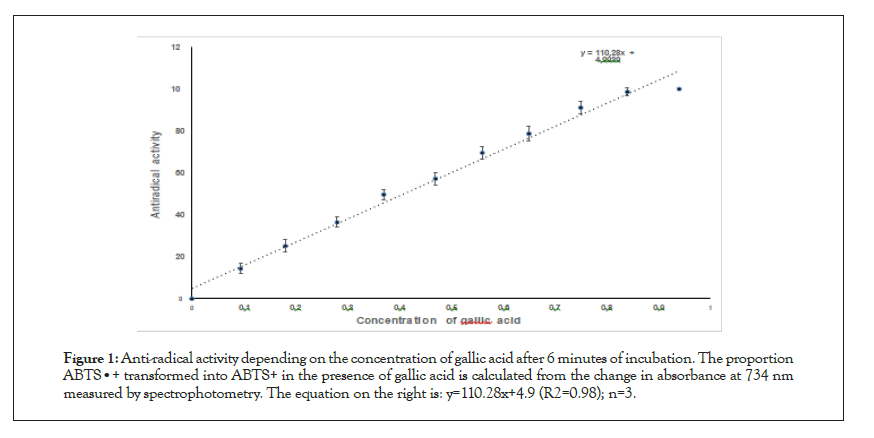
Figure 1: Anti-radical activity depending on the concentration of gallic acid after 6 minutes of incubation. The proportion ABTS•+ transformed into ABTS+ in the presence of gallic acid is calculated from the change in absorbance at 734 nm measured by spectrophotometry. The equation on the right is: y=110.28x+4.9 (R2=0.98); n=3.
Notes: According to the data listed in the (Table 1) above, there are no hypertensives in the study population; 5 out of 10 are overweight (BMI>25). Half of the women consumed 2 fruits and vegetables per day, the other half consumed only 1 fruit and vegetable. All women in the study were non-smokers.
| N° | Age | BMI | SBP/DBP | Gestation | Parity | Fruit(s)and vegetable(s) | Antiradical activity (%) |
|---|---|---|---|---|---|---|---|
| 1 | 24 | 22,5 | 126/82 | 0 | 0 | 1/day | 31,9 ± 0,01 |
| 2 | 29 | 30,45 | 119/85 | 2 | 1 | 1/day | 29,71 ± 0,4 |
| 3 | 36 | 21,40 | 123/80 | 1 | 1 | 2-3/day | 37,3 ± 1,4 |
| 4 | 37 | 26,35 | 116/74 | 5 | 2 | 1/day | 30,24 ± 0,7 |
| 5 | 40 | 24,5 | 110/60 | 1 | 0 | 1/day | 34,7 ± 2,9 |
| 6 | 44 | 29,4 | 110/70 | 4 | 2 | 2-3/day | 38,28 ± 0,9 |
| 7 | 45 | 23,90 | 101/66 | 4 | 3 | 2-3/day | 32,55 ± 1,7 |
| 8 | 46 | 28,37 | 110/70 | 5 | 3 | 2-3/day | 34,95 ± 1,4 |
| 9 | 47 | 26,50 | 1280/79 | 7 | 5 | 2-3/day | 34,73 ± 0,5 |
| 10 | 50 | 29 | 135/87 | 7 | 4 | 1/day | 34,28 ± 1,5 |
Note: SBP: Systolic Blood Pressure, DBP: Diastolic Blood Pressure, BMI: Body Mass Index.
Table 1: General characteristics of the study population.
Comparison of the antiradical activity of all women
The results of the plasma anti-radical activity of all healthy women between the ages of 24 and 50 years are shown in Figure 2. These results do not suggest a clear relationship between free radical scavenging activity and the age of the individual women. Indeed, we can observe either a slight increase, followed by a slight decrease or vice versa, of the antiradical activity with age. For example, the antiradical activity of the plasma of the 37 year old subject is 30.2%; it is 38.28% for the 44 year old subject and falls back to 34.28% for the 50 year old subject.
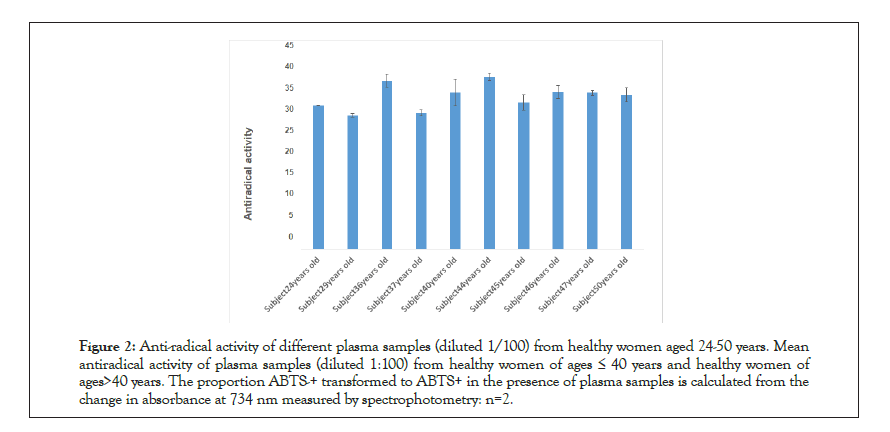
Figure 2: Anti-radical activity of different plasma samples (diluted 1/100) from healthy women aged 24-50 years. Mean antiradical activity of plasma samples (diluted 1:100) from healthy women of ages ≤ 40 years and healthy women of ages>40 years. The proportion ABTS-+ transformed to ABTS+ in the presence of plasma samples is calculated from the change in absorbance at 734 nm measured by spectrophotometry: n=2.
Effect of age on antiradical activity
We divided the women into two groups according to age, and we looked at the evolution of the antiradical activity in the 2 groups. Group 1 includes women under 40 years of age and group 2 includes women between 40 and 50 years of age. The results obtained are shown in Figure 3 below. According to these, the average antiradical activity of women aged 40 years was 2.2% higher than that of women aged ≤ 40 years. Indeed, this average activity is 34.96 ± 2.08% for subjects of age 40 years and 32.8 ± 3.22% for those of age ≤ 40 years.
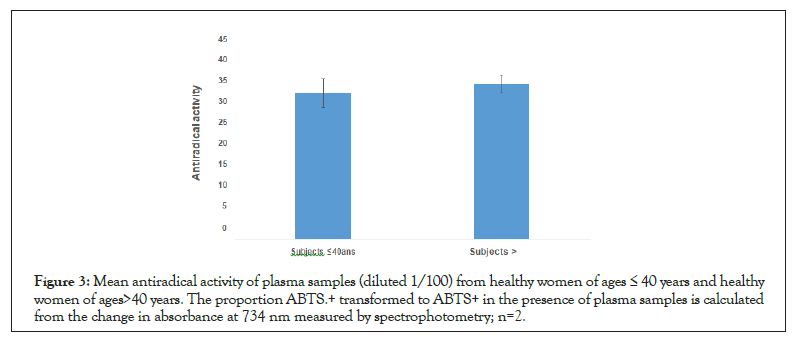
Figure 3: Mean antiradical activity of plasma samples (diluted 1/100) from healthy women of ages ≤ 40 years and healthy women of ages>40 years. The proportion ABTS.+ transformed to ABTS+ in the presence of plasma samples is calculated from the change in absorbance at 734 nm measured by spectrophotometry; n=2.
Effect of BMI and age on antiradical activity
The mean free radical scavenging activity of healthy women with a BMI less than 25 and a mean age of 36.25 ± 8.95 years was compared with that of healthy overweight women with a mean age of 42.16 ± 7.78 years and a BMI greater than 25. The results obtained are grouped in Figure below. According to the results, the antiradical activity of overweight women with a BMI greater than 25 and an average age of 42.16 ± 7.78 years is more or less equivalent to that of women with a BMI less than 25 and an average age of 36.25 ± 8.95 years. The antiradical activity of women with a BMI˂25 is slightly higher than that of women with a BMI>25. Indeed, the average antiradical activity was 34.15 ± 2.469% for women with a BMI˂25 versus 33.69 ± 3.22% for those with a BMI>25 (Figure 4).
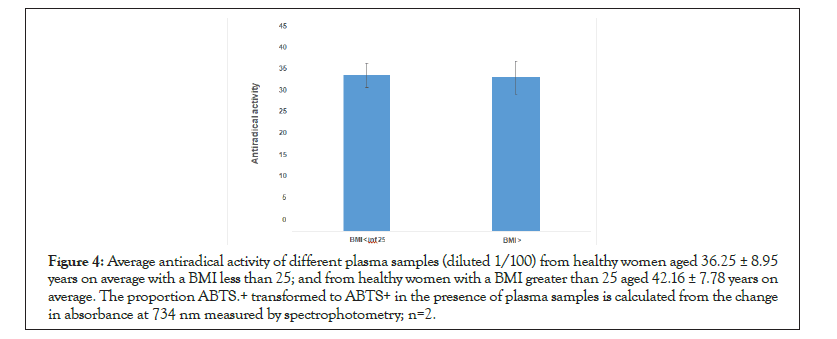
Figure 4: Average antiradical activity of different plasma samples (diluted 1/100) from healthy women aged 36.25 ± 8.95 years on average with a BMI less than 25; and from healthy women with a BMI greater than 25 aged 42.16 ± 7.78 years on average. The proportion ABTS.+ transformed to ABTS+ in the presence of plasma samples is calculated from the change in absorbance at 734 nm measured by spectrophotometry; n=2.
Effect of age and gestation on antiradical activity
The average antiradical activity was compared in women with gestations lower than 3 and an average age of 32.25 ± 7.13%, and women with gestations greater than or equal to 3 with an average age of 44.83 ± 4.35%. The results obtained are grouped in Figure 5 below. According to these results, the average antiradical activity of the group of women with less than 3 gestations and a mean age of 32.25 ± 7.13% is little different from that of women with gestations ≥ 3 with a mean age of 44.83 ± 4.35%. Indeed, the antiradical activities obtained are 33.44 ± 3.3% and 34.17 ± 2.67%, respectively (Figure 5).
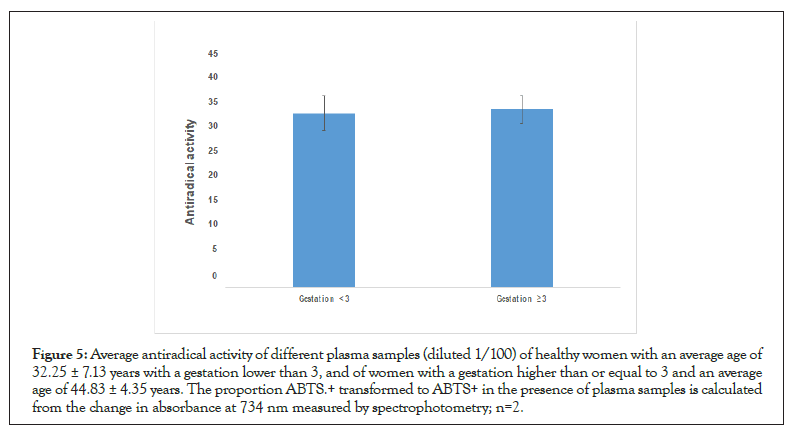
Figure 5: Average antiradical activity of different plasma samples (diluted 1/100) of healthy women with an average age of 32.25 ± 7.13 years with a gestation lower than 3, and of women with a gestation higher than or equal to 3 and an average age of 44.83 ± 4.35 years. The proportion ABTS.+ transformed to ABTS+ in the presence of plasma samples is calculated from the change in absorbance at 734 nm measured by spectrophotometry; n=2.
Effect of parity and age on antiradical activity
The results of the average antiradical activities of healthy women with parities less than 3 and a mean age of 35 ± 7.32 years, and of women with parities greater than or equal to 3 with a mean age of 47.83 ± 2.16% are shown in Figure 6. According to these, the values of antiradical activities of the two groups of women are more or less identical. Indeed, the average antiradical activity of the plasma of women with parity lower than 3 is 33.71 ± 3.65% against 34.13 ± 1.08% for those with parity greater than or equal to 3 (Figure 6).
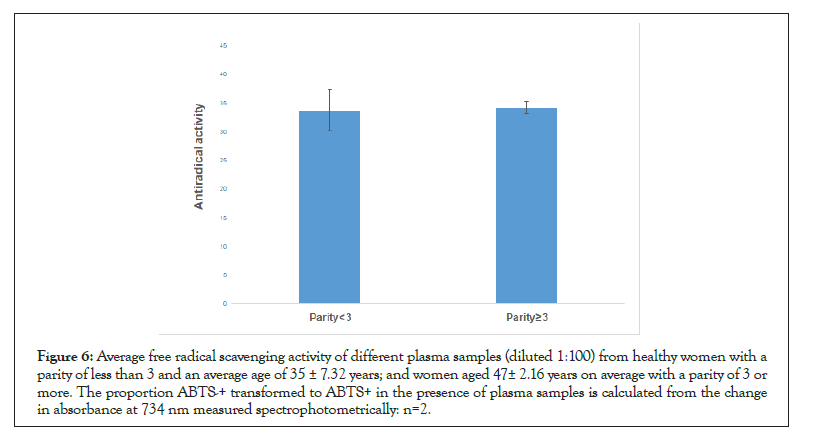
Figure 6: Average free radical scavenging activity of different plasma samples (diluted 1:100) from healthy women with a parity of less than 3 and an average age of 35 ± 7.32 years; and women aged 47± 2.16 years on average with a parity of 3 or more. The proportion ABTS-+ transformed to ABTS+ in the presence of plasma samples is calculated from the change in absorbance at 734 nm measured spectrophotometrically: n=2.
Effect of fruit and vegetable consumption and age on antiradical activity
The mean plasma free radical scavenging activity of women with a mean age of 36 ± 10.07 years and consuming 1 fruit and vegetable per day was compared with that of women consuming 2 fruits and vegetables per day with a mean age of 43.6 ± 4.39 years. According to the results obtained in Figure 7, the antiradical activity of the plasma of women consuming 2 to 3 fruits and vegetables per day is approximately 3.5% higher than that of women consuming only 1 fruit and vegetable/day. Indeed, the average plasma antiradical activity is 32.16 ± 2.27% in women consuming only one fruit and vegetable per day and 35.56 ± 2.26% in those consuming 2 to 3 fruits and vegetables (Figure 7).
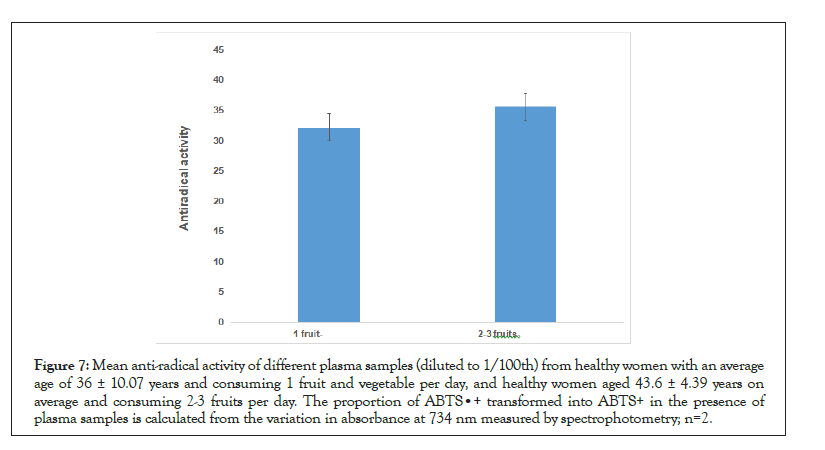
Figure 7: Mean anti-radical activity of different plasma samples (diluted to 1/100th) from healthy women with an average age of 36 ± 10.07 years and consuming 1 fruit and vegetable per day, and healthy women aged 43.6 ± 4.39 years on average and consuming 2-3 fruits per day. The proportion of ABTS•+ transformed into ABTS+ in the presence of plasma samples is calculated from the variation in absorbance at 734 nm measured by spectrophotometry; n=2.
Our study focused on the evaluation of the antiradical activity of plasma from healthy women aged 24 to 50 years, without any chronic pathology with a proven link with the presence of antioxidant stress. This was done in order to observe the effect of ageing or aging on the antiradical capacity of blood. The anti-radical activity was measured by trapping the free radical ABTS+ According to the method of Re et al. [16] optimized by N’negue et al. [17] with gallic acid as the standard antioxidant. In this method, the concentration of the radical cation ABTS•+, blue-green in color absorbing at 734 nm, decreases in the presence of an antioxidant compound capable of trapping said radical and reducing it to a non-radical ABTS+ molecule. This will result in a decrease in absorbance at 734 nm and a discoloration of the solution. According to Fischer et al. [18], this test can be applied routinely to predict the total antioxidant capacity of the blood. The results of the antioxidant activity of gallic acid (a synthetic strongly antioxidant molecule) validate the chosen method (Figure 1). The IC50 value of gallic acid deduced from our results was 2 μM. This value is equivalent to that obtained by Sadat et al. [19] and N’negue et al. [17,20], which worked under the same conditions. The results of the antiradical activity of the plasmas of women aged between 24 and 50 years presented in Figure 4; do not show a clear relationship between the antiradical activity and the age of the women. Indeed, we can observe either a slight increase, followed by a decrease or inversely, of the antiradical activity with the age of the women. However, when we group the women into age groups in Figure 5, the average antiradical activity of women over 40 years of age is 2.2% higher than that of women under or equal to 40 years. We can explain this slight increase in antiradical activity beyond the age of 40 by the following two hypotheses. The first hypothesis would be the presence of a slight oxidative stress in the blood of women over 40 years of age, with a consequent increase in antiradical compounds to fight against the free radicals generated by this oxidative stress. Moreover, according to the literature, oxidative stress may result in an increase in oxidative activity [21]. It should be remembered that the main cause of aging is the presence of free radicals in the body [15,5]. Approximately 5% of the oxygen consumed during respiration is lost in our cells in the form of oxygenated free radicals leading to progressive deterioration of mitochondrial DNA, a sign of aging. The frequency of mtDNA deletions, and thus the production of oxygenated free radicals, would increase exponentially from the age of 50 onwards to reach considerable levels in older people. The second hypothesis would be an increase of antiradical compounds in the blood of these women over 40 years of age due to a diet rich in antiradical compounds such as fruits and vegetables. According to the literature, fruits and vegetables are rich in antiradical compounds such as phenolics, polyphenols, flavonoids, carotenoids, anthocyanins, vitamin C and E [22-27]. Our results on the effect of fruit and vegetable consumption and age on the average antiradical activity of women (Figure 6) validate our hypotheses. Indeed, according to these results, the average antiradical activity of women consuming 2 to 3 fruits and vegetables per day with an average age of 43.6 ± 4.39 years was 3.5% higher than that of women consuming 1 fruit and vegetable per day with an average age of 36 ± 4.39 years. These results confirm both the presence of mild age-related oxidative stress and the increase in antiradical activity associated with high fruit and vegetable consumption. The effect of BMI and age on the antiradical activity of women (Figure 7) showed that women with an average age of 36.25 ± 8.95 years with a normal body build (BMI˂25) have an average antiradical activity (34.15 ± 2.46%) casi-identical to that of overweight women (BMI to 25) with an average age of 42.16 ± 7.78 years (33.69 ± 3.22%). The activity of normal-build women was just slightly higher than that of overweight women. We can explain the decrease in antiradical activity in women over 40 years of age by their overweight state. Indeed, in recent work, N'negue et al. [28] show that a high BMI increases oxidative stress in women with uterine myomas. The decrease in plasma free radical scavenging activity can be explained by a prior internal reaction between non- enzymatic blood free radical scavenging molecules (total phenolics, flavonoids, uric acid, ascorbic acid, alpha-tocopherol, beta- carotene, reduced glutathione (GSH), bilirubin, lipid peroxidation products, etc.) and plasma free radicals from oxidative stress. This decreases the level of plasma antiradical molecules likely to trap the free radical ABTS•+. The consequence is a decrease of the measured antiradical activity. The effect of gestation and age on the one hand, and parity and age on the other, on the antiradical activity of women's plasma showed fairly similar results. Indeed, according to the results obtained, women with an average age of 32.25 ± 7.13 years and a parity of less than 3 showed an average antiradical activity not very different from that of women with parity greater than or equal to 3 and an average age of 44.83 ± 4.35 years. Similarly, women with an average age of 35 ± 7.32 years with a parity of less than 3 showed a mean antiradical activity more or less equal to that of women with a parity of greater than or equal to 3 and a mean age of 47 ± 2.16 years. We can deduce from these results that high gestation and parity (≥ 3) would decrease oxidative stress from age gain. This result is in agreement with the literature. Indeed, studies have shown that gestation and parity would have protective effects against the appearance of oxidative stress in women with uterine myomas [28]. We can therefore extrapolate that gestation and parity slow down the onset of stress in diseases whose etiology is free radicals and in the aging process.
This study has shown by the ABTS method that a slight oxidative stress is already progressively established in the blood plasma of women under or equal to 50 years of age. That the consumption of fruits and vegetables provides antioxidant compounds capable of trapping free radicals produced by the body throughout the aging process. This could slow down the process of cellular aging and the appearance of chronic pathologies whose etiology would be linked to oxidative stress. This study also shows that a gestation and a parity superior or equal to 3 slow down the appearance of oxidative stress.
[Cross ref] [Google Scholar] [PubMed].
[Cross ref] [Google Scholar] [PubMed].
[Cross ref] [Google Scholar] [PubMed].
[Cross ref] [Google Scholar] [PubMed].
[Cross ref] [Google Scholar] [PubMed].
[Cross ref] [Google Scholar] [PubMed].
[Cross ref] [Google Scholar] [PubMed].
[Cross ref] [Google Scholar] [PubMed].
[Cross ref] [Google Scholar] [PubMed].
[Cross ref] [Google Scholar] [PubMed].
[Cross ref] [Google Scholar] [PubMed].
[Cross ref] [Google Scholar] [PubMed].
[Cross ref] [Google Scholar] [PubMed].
[Cross ref] [Google Scholar] [PubMed].
[Cross ref] [Google Scholar] [PubMed].
[Cross ref] [Google Scholar] [PubMed].
[Cross ref] [Google Scholar] [PubMed].
[Cross ref] [Google Scholar] [PubMed].
[Cross ref] [Google Scholar] [PubMed].
[Cross ref] [Google Scholar] [PubMed].
[Cross ref] [Google Scholar] [PubMed].
[Cross ref] [Google Scholar] [PubMed].
[Cross ref] [Google Scholar] [PubMed].
[Cross ref] [Google Scholar] [PubMed].
[Cross ref] [Google Scholar] [PubMed].
[Cross ref] [Google Scholar] [PubMed].
[Cross ref] [Google Scholar] [PubMed].
[Cross ref] [Google Scholar] [PubMed].
Citation: Mezui-Mbeng N, Komba M, Ntamack B, Ovouele N, Lendoye E, Engonga E (2022) Study of the Effect of Age, Body Mass Index, Gestation, Parity, and Fruit and Vegetable Consumption on Plasma Antioxidant Activity of Healthy Women by Scavenging the Radical ABTS. J Clin Chem Lab Med. 5:205.
Received: 06-Jan-2022, Manuscript No. JCCLM-22-15410; Editor assigned: 10-Jan-2022, Pre QC No. JCCLM-22-15410 (PQ); Reviewed: 25-Jan-2022, QC No. JCCLM-22-15410; Revised: 28-Jan-2022, Manuscript No. JCCLM-22-15410 (R); Published: 07-Feb-2022 , DOI: 10.35248/JCCLM.22.05.205
Copyright: © 2022 Mezui-Mbeng N, et al. This is an open-access article distributed under the terms of the Creative Commons Attribution License, which permits unrestricted use, distribution, and reproduction in any medium, provided the original author and source are credited.